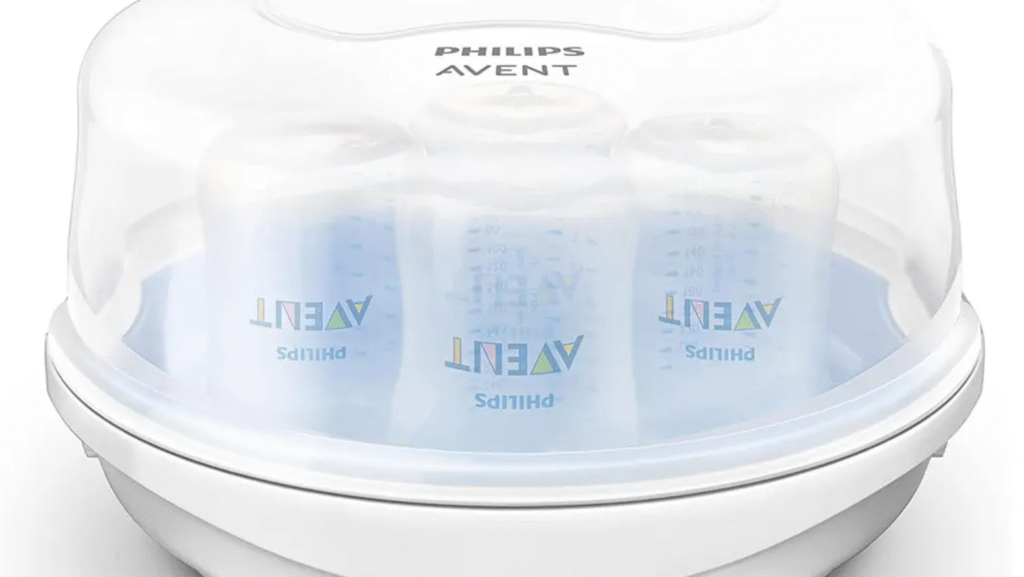Keeping baby bottles, pacifiers, and feeding accessories clean is one of the most critical responsibilities for parents. Babies have developing immune systems, which means they are more vulnerable to germs and infections. It is where a microwave steam sterilizer becomes an essential tool in every household with a newborn.
Compact, fast, and easy to use, this device offers an efficient way to sterilize feeding items using steam—no harsh chemicals are needed. Let’s explore everything you need to know about microwave steam sterilizers, from how they work to their benefits and tips for choosing the right one.
What is a Microwave Steam Sterilizer?
A microwave steam sterilizer is a specially designed container that uses the power of your microwave to create high-temperature steam, killing harmful bacteria and germs.
You place your baby bottles, nipples, pacifiers, and other small feeding accessories inside, add the recommended amount of water, close the lid, and microwave for the required time—usually 2 to 8 minutes. The heat generated turns water into steam, penetrating every surface, leaving the items clean and safe for your baby.
Why Sterilization Matters for Babies
A quick wash with warm soapy water may be enough for adults, but babies are far more sensitive to bacteria and viruses.
- Immature immune systems can’t fight off infections like older children or adults.
- If left inside bottles, milk residue can quickly become a breeding ground for harmful bacteria.
- Regular sterilization helps reduce the risk of illnesses like diarrhea, colic, and oral thrush.
A microwave steam sterilizer ensures your baby’s feeding gear is hygienic without exposing them to chemical cleaning agents.
How a Microwave Steam Sterilizer Works
The process is simple, yet highly effective:
- Add Water – Typically, you’ll need about 200 ml (or as specified by the manufacturer).
- Load Items – Arrange bottles, nipples, rings, and pacifiers inside without overcrowding.
- Close and Microwave – Heat for the recommended time based on your microwave’s wattage.
- Cool Before Use – Let the sterilizer cool down before removing items to avoid burns.
The steam’s heat reaches temperatures high enough to kill 99.9% of common household bacteria without needing bleach or other disinfectants.
Benefits of a Microwave Steam Sterilizer
A microwave steam sterilizer offers multiple advantages over traditional boiling or electric sterilizers:
1. Time-Saving
Most models sterilize in just a few minutes, making it ideal for busy parents.
2. Chemical-Free Cleaning
The sterilization relies solely on water and heat, ensuring no chemical residues on feeding items.
3. Energy-Efficient
Since it uses your existing microwave, it consumes less electricity than electric sterilizers.
4. Portable and Compact
Many microwave steam sterilizers are lightweight and small enough to take when traveling.
5. Multipurpose Use
You can sterilize bottles, breast pump parts, teething toys, and small utensils.
How to Choose the Best Microwave Steam Sterilizer
When buying a microwave steam sterilizer, consider the following features:
Capacity
Some sterilizers hold up to six bottles simultaneously, while compact models only fit two or three. Choose based on how many bottles you use daily.
Microwave Compatibility
Check the dimensions to ensure it fits inside your microwave. Some models are too tall for smaller ovens.
Sterilization Time
Different brands vary in heating times—shorter cycles are great for quick turnarounds.
BPA-Free Materials
Always choose sterilizers made from safe, non-toxic, BPA-free plastics to avoid harmful chemicals leaching into baby items.
Ease of Cleaning
Look for models with fewer parts, making them easy to wash after each use.
Tips for Using a Microwave Steam Sterilizer Safely
- Follow the manufacturer’s Instructions – Different models have different water levels and timings.
- Do Not Overcrowd – Steam needs to circulate freely for effective sterilization.
- Use Clean Water – Avoid unfiltered tap water if it’s high in mineral content to prevent scaling.
- Cool Before Opening – Steam can cause burns, so wait a minute before removing the lid.
- Regular Maintenance – Descale periodically to keep the sterilizer working efficiently.
Microwave Steam Sterilizer vs. Electric Sterilizer
Pur Microwave Steam Sterilizer Electric Sterilizer
Speed 2–8 minutes 5–15 minutes
Portability, Lightweight and compact, Bulkier
Cost: Usually cheaper, more expensive
Ease of Use: Very simple, Simple but more setup
Energy Consumption Uses microwave power, Direct electricity
If you already have a microwave and want a fast, affordable solution, a microwave steam sterilizer is a great choice. However, if you sterilize large quantities daily, an electric model may be more convenient.
Common Mistakes to Avoid
- Using Too Little or Too Much Water—Incorrect water levels can cause poor sterilization or even damage to the sterilizer.
- Not Cleaning Before Sterilizing – Sterilization kills germs but does not remove milk residue; always wash bottles first.
- Leaving Items Inside Too Long – Some plastics can warp if left inside after the cycle ends.
-
-
- Ignoring the manufacturer’s Microwave Wattage Guide – Overheating may damage items or sterilizers.
-
-






